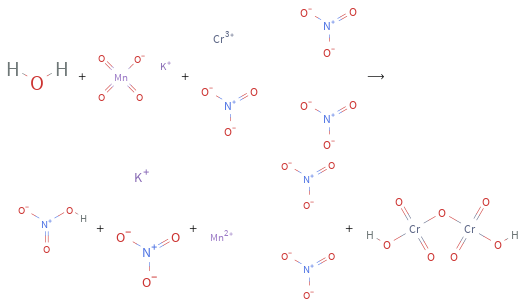Input interpretation

H_2O water + KMnO_4 potassium permanganate + CrN_3O_9 chromium nitrate ⟶ HNO_3 nitric acid + KNO_3 potassium nitrate + Mn(NO_3)_2 manganese(II) nitrate + H_2Cr_2O_7 dichromic acid
Balanced equation

Balance the chemical equation algebraically: H_2O + KMnO_4 + CrN_3O_9 ⟶ HNO_3 + KNO_3 + Mn(NO_3)_2 + H_2Cr_2O_7 Add stoichiometric coefficients, c_i, to the reactants and products: c_1 H_2O + c_2 KMnO_4 + c_3 CrN_3O_9 ⟶ c_4 HNO_3 + c_5 KNO_3 + c_6 Mn(NO_3)_2 + c_7 H_2Cr_2O_7 Set the number of atoms in the reactants equal to the number of atoms in the products for H, O, K, Mn, Cr and N: H: | 2 c_1 = c_4 + 2 c_7 O: | c_1 + 4 c_2 + 9 c_3 = 3 c_4 + 3 c_5 + 6 c_6 + 7 c_7 K: | c_2 = c_5 Mn: | c_2 = c_6 Cr: | c_3 = 2 c_7 N: | 3 c_3 = c_4 + c_5 + 2 c_6 Since the coefficients are relative quantities and underdetermined, choose a coefficient to set arbitrarily. To keep the coefficients small, the arbitrary value is ordinarily one. For instance, set c_7 = 1 and solve the system of equations for the remaining coefficients: c_1 = 11/5 c_2 = 6/5 c_3 = 2 c_4 = 12/5 c_5 = 6/5 c_6 = 6/5 c_7 = 1 Multiply by the least common denominator, 5, to eliminate fractional coefficients: c_1 = 11 c_2 = 6 c_3 = 10 c_4 = 12 c_5 = 6 c_6 = 6 c_7 = 5 Substitute the coefficients into the chemical reaction to obtain the balanced equation: Answer: | | 11 H_2O + 6 KMnO_4 + 10 CrN_3O_9 ⟶ 12 HNO_3 + 6 KNO_3 + 6 Mn(NO_3)_2 + 5 H_2Cr_2O_7
Structures

+ + ⟶ + + +